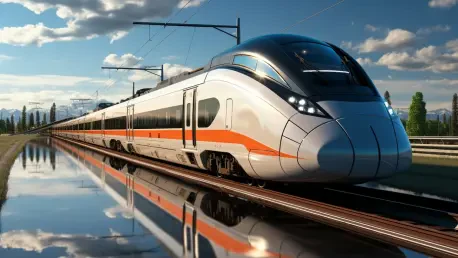VIA Rail is currently grappling with a heightened demand for its services, particularly within the Quebec-Windsor Corridor, and the challenges presented by outdated infrastructure. Despite the clear sign of demand reflected in frequently booked trains, the reality is bittersweet as this also results in sold-out departures and elevated ticket prices. Such circumstances render rail travel less accessible to the general public. This situation underscores an urgent need for infrastructural upgrades to make rail travel both affordable and efficient. Compounding the issue, the long-anticipated High Frequency Rail project, now renamed Alto HSR, faces delays in operational timelines, pushing its expected debut out to 2039 or beyond.
Infrastructural Constraints and Passenger Demand
The existing infrastructure of VIA Rail is simply not geared to handle the surging demand seen in recent years. While full trains provide jubilant proof of interest and a potential revenue stream, they paradoxically limit access for numerous travelers due to prohibitive costs and lack of availability. Travel times, frustratingly, have not improved despite technological advancements. In fact, they are slower than in past decades due to outdated tracks and scheduling inefficiencies. Issued timetable comparisons reveal the pressing need for a more extensive rail system that can support a growing populace eager for efficient mobility between cities. This bottleneck situation hinders potential growth in passenger numbers and detracts from service quality.
The CN Kingston Subdivision illustrates this infrastructural inadequacy, as it supports only a limited number of passenger trains daily. Given the high demand, these trains often operate with an excessive number of cars, which in turn leads to longer travel times. The expectation had been that the High Frequency Rail initiative would bring much-needed relief through dedicated passenger tracks; however, its inability to materialize has perpetuated VIA Rail’s struggle to meet market needs effectively. The conundrum stands: how to immediately enhance the network when long-term solutions linger far on the horizon. The company finds itself at a crossroads where strategic investments and infrastructural revitalization must be urgently prioritized to ensure service accessibility and affordability.
Operational Challenges and Temporary Measures
Beyond the infrastructural limitations, VIA Rail faces a host of operational hurdles that manifest in unreliable service. One of the more glaring issues stems from the reliance on outdated rolling stock. To meet current demands, VIA Rail continues to utilize HEP2 cars, relics of the 1940s, which were never intended as a long-term solution. These cars not only lag in speed and fuel efficiency but also add to maintenance expenditures, straining the financial resources of VIA Rail at a time when every dollar counts. Given these old cars are more challenging to access and costly to maintain, their continued use embodies a temporary and unsustainable fix to a mounting problem.
The delay in the Alto HSR project exacerbates these operational challenges, compelling VIA Rail to continue with practices that hamper efficiency and service quality. Anticipated improvements with Alto HSR promised enhanced dispatching capabilities and faster, dedicated tracks—a significant upgrade over current offerings. However, fleet management inevitably suffers given the delays, highlighting the necessity for preventative short-term actions that could serve as a bridge until Alto HSR comes online. Identifying sustainable interim measures is therefore crucial to mediating the inefficiencies that currently undermine VIA Rail’s ability to serve growing passenger numbers while maintaining a fleet that can bolster its operational footprint.
Calls for Governmental Intervention
Prospects for VIA Rail’s investors and stakeholders are intrinsically linked to governmental intervention, which stakeholders advocate for as elevated passenger demand continues to overwhelm existing infrastructure. The federal government holds crucial leverage in facilitating VIA Rail’s expansion and reform. The acquisition of additional economy-class Venture cars ranks as one of the immediate steps proposed by Transport Action, a call to action that prioritizes accommodating demand, enabling maintenance rotations, and alleviating immediate capacity concerns within VIA Rail’s operations. Though important, procuring these cars is but a first move in a broader reshuffle needed for efficiency gains and long-term sustainability.
Efforts to overhaul the rail system require comprehensive reforms not confined to rolling stock enhancements. This encompasses refined train dispatching, robust track maintenance strategies, improved signaling, and modernized station facilities. Such upgrades necessitate stringent regulatory oversight of entities like CN and Metrolinx to prompt modest infrastructure advances that can neutralize existing bottlenecks. The Coteau junction represents a palpable example of a location vehemently in need of attention and improved protocols. Securing the foundational viability of operations, enabling enhancements, and maintenance funding are equally essential to cultivating an environment where VIA Rail thrives within and beyond the constraints of its current 32-train fleet, ensuring passenger satisfaction while boosting returns on investments.
Toward a Robust and Future-Proof Network
VIA Rail is facing increased demand, particularly in the Quebec-Windsor Corridor, and dealing with the problems of outdated infrastructure. While the frequent booking of trains highlights this demand, it also leads to sold-out departures and higher ticket prices, which makes rail travel less accessible to many people. This situation stresses the pressing need for infrastructure improvements to ensure rail travel can be both affordable and efficient. The circumstances are further aggravated by delays in the much-anticipated High Frequency Rail project, now known as Alto HSR, which has pushed its expected operation start to 2039 or later. These upgrades are crucial for meeting public demand and ensuring that the railway system can handle a rising number of passengers without compromising affordability or efficiency. Such delays in long-term projects can result in various economic and logistical challenges, making it difficult for everyday commuters to rely on the rail system as a viable and cost-effective transportation option in the near future.









